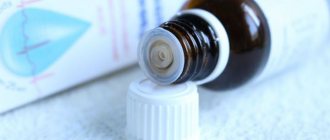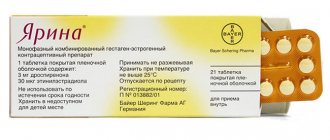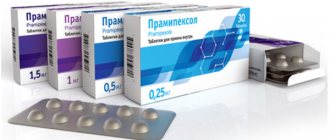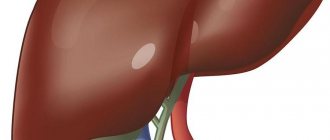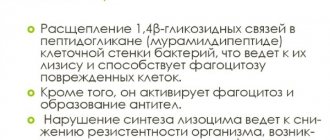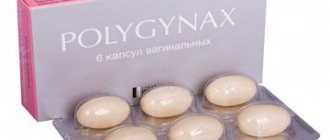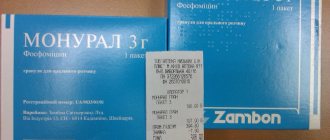SEHYDRIN
Tablets, enteric-coated,
red-brown in color; white tablet core; On a cross section, two layers are visible.
| 1 tab. | |
| hydrazine sulfate | 60 mg |
Excipients: disubstituted calcium phosphate, polyvinylpyrrolidone, magnesium stearate, highly dispersed silicon dioxide, dimethicone, talc, polymethacrylate, polyethylene glycol 600, red iron oxide (E172), titanium dioxide.
10 pieces. – contour cell packaging (5) – cardboard packs. 50 pcs. – polymer jars (1) – cardboard packs.
pharmachologic effect
The drug suppresses the growth of tumors, affects a number of biochemical parameters: inhibits monoamine oxidase activity, reduces the permeability of cell membranes and biomembranes of subcellular structures, and is an inhibitor of xenobiotic metabolism. It has a symptomatic therapeutic effect for malignant neoplasms in advanced stages. It does not have myelosuppressive and other side effects characteristic of many other anticancer drugs.
Pharmacokinetics
the drug in the blood of sick people reaches a maximum 2 hours after taking 60 mg (1 tablet); a day later, small amounts of it are still detectable in the serum. When blood is collected 9 hours after the end of a 30-day course of treatment, from 0 to 89 ng/ml Sehydrin is detected in different patients.
A study of the pharmacokinetics of Sehydrin was also carried out on outbred intact rats and animals with sarcoma 45. The drug is rapidly absorbed from the gastrointestinal tract; cleansing the blood from it ends by 25-28 hours after intragastric administration at a dose of 100 mg/kg.
The maximum concentration in the blood of intact animals occurs approximately 50 minutes after administration, in tumor carriers (sarcoma 45) - after 3 hours.
Excretion in urine in healthy animals lasts up to 3 days and is approximately 50% of the administered amount; in tumor carriers, elimination ends between the first and second days, and only 25% of the drug is eliminated. The volume of distribution in intact rats is 14 ml, in the presence of a tumor - 29.4 ml.
Tumor carriers are prone to accumulation of Sehydrin. Sehydrin is oxidized in the body, and its undegraded part is excreted in the urine, partially in acetylated form (in rats and rabbits).
Indications
— symptomatic treatment of locally advanced and disseminated forms of malignant neoplasms.
In this case, the drug Sehydrin has a pronounced symptomatic effect: reduction or elimination of pain (up to the point of drug withdrawal), feelings of weakness, symptoms of respiratory failure (shortness of breath), cough, fever, improved appetite, increased physical activity. The drug is prescribed to patients with malignant neoplasms in advanced stages (including in the preterminal phase of the process).
Contraindications
- hypersensitivity to hydrazine sulfate and other components of the drug;
- simultaneous use with all types of alcohol and barbiturates;
- pregnancy and lactation;
- children's age (due to lack of experience in use).
Carefully:
with severe dysfunction of the liver and kidneys.
Dosage
Sehydrin is prescribed orally 1-2 hours before or 1-2 hours after meals or taking other medications. Adults take the drug 1 tablet 3 times a day. Course dose – 100 tablets. If tolerance is unsatisfactory, the daily dose is reduced to 2 tablets per day. The dose for the course of treatment may not change.
A repeated course of treatment is carried out at intervals of at least 14 days. The number of courses is not limited, and the intervals between courses are increased by 1-2 weeks.
Dyspeptic symptoms are possible (nausea, vomiting, belching), which quickly disappear with a dose reduction or a short-term (two- or three-day) break in treatment. Rare complications - insomnia, general agitation, mild and transient symptoms of polyneuritis.
For dyspeptic symptoms, astringents and anti-inflammatory drugs (chamomile infusion, romazulan, vikalin), antispasmodics and antiemetics are prescribed internally.
For neurotoxic effects, it is advisable to use pyridoxine hydrochloride (5% solution of vitamin B6, 1 ml intramuscularly 1-2 times a day), thiamine chloride (vitamin B1), oral multivitamin preparations and intravenous administration of a 20-40% solution of dextrose (glucose).
Drug interactions
Simultaneous use of Sehydrin with barbiturates, ethanol, tranquilizers, antipsychotic drugs (neuroleptics) can lead to a sharp increase in the toxicity of Sehydrin.
In experiments on laboratory animals, in the case of preliminary administration of Sehydrin, the effectiveness of treatment with many antitumor drugs increases (with the exception of cyclophosphamide).
special instructions
Treatment with Sehydrin should be carried out under the supervision of a physician experienced in the use of anticancer drugs.
The drug is prescribed with caution to patients with severe impairment of liver and kidney function. The use of the drug for jaundice caused by liver metastases (especially obstructive) is not contraindicated.
Due to the lack of myelotoxicity, Sehydrin is used in patients with cytopenia resulting from radiation therapy and chemotherapy.
Pregnancy and lactation
Contraindicated during pregnancy and lactation.
For impaired renal function
Use caution in case of severe renal impairment.
For liver dysfunction
Use caution in case of severe liver dysfunction.
Storage conditions and periods
List B. In a dry place, protected from light, at a temperature not exceeding 25°C. Keep out of the reach of children! Shelf life – 3 years.
The description of the drug SEHYDRIN is based on the officially approved instructions for use and approved by the manufacturer.
Found an error? Select it and press Ctrl+Enter.
Source: https://health.mail.ru/drug/sehydrin/
Main effects and mechanisms of action of sehydrin
WITH
ehydrin, the main ingredient of which is
hydrazine sulfate
, does not have a direct cytotoxic effect, but is a very biologically active substance (V. Ya. Rusin). Moreover, its toxicity is relatively low (for example, LD50 for mice when administered orally is 740 mg/kg).
We studied sehydrin in an experiment for antitumor activity. Solid (sarcoma 37, Ehrlich carcinoma, squamous cell skin cancer, sarcoma 180, Walker carcinosarcoma) and ascitic (sarcoma 37, Ehrlich carcinoma, Seidel hepatoma, NK/Ly lymphocytic leukemia) variants of allogeneic tumors were used (V.A. Filov et al., 1983 ). In the case of solid tumors, the effect of tumor growth inhibition was obtained only on Walker carcinosarcoma. In the treatment of ascites tumors, a moderate but significant effect of tumor growth inhibition was achieved on sarcoma 37 and NK/Ly lymphocytic leukemia (50–55%) and a significant effect on Seidel hepatoma – 85%.
The results obtained were sufficient to submit the drug to the Pharmacological Committee of the Ministry of Health to consider conducting clinical trials, although compared to conventional cytostatics they were more modest. However, the unusual nature of the substance, the clearly different mechanism of its possible action compared to other antitumor drugs, the absence of hematological and any other significant side effects indicated the feasibility of such a study. As a result of the first phase of the clinical study, a regimen for using the drug was developed: sehydrin in enteric-coated tablets was prescribed 3 times a day, 60 mg 1-2 hours after meals daily for 30-40 days. After a break of 2-3 weeks, the course can be repeated. In principle, the number of courses is not limited, provided that the intervals between them are gradually increased.
Clinical study in phase 2 was conducted in 5 clinics
(Moscow Institute of Oncology named after Herzen; Institute of Radiology and Oncology in Vilnius; Rostov Research Institute of Oncology; Kiev Institute of Oncology Problems named after R.E. Kavetsky and Research Institute of Oncology named after N.N. Petrov in St. Petersburg). Treatment was carried out for patients with common forms of solid malignant tumors, including relapses and metastases, malignant lymphomas in generalized stages and relapses of desmoids, subject only to symptomatic therapy, who did not take any treatment at least 2 months before the start of the course of sehydrin. The vast majority of these patients had previously been subjected to various types of special treatment (surgical, radiation, cytostatic, hormonal), the possibilities of which were exhausted by the time sehydrin was prescribed. Repeated courses were prescribed if the process stabilized; usually their number was 2–3, but in some cases reached 10, 20, 40 (in particular, with neuroblastoma). For patients who noted difficulty in taking tablets (for cancer of the esophagus, larynx, pharynx), sehydrin was prescribed in the form of a 0.4% solution, dosing it by volume (1 tablet is equivalent to 15 ml). Along with sehydrin, the intake of alcohol and barbiturates was prohibited and the consumption of cheese was limited.
The effect of sehydrin was assessed at the end of the treatment course. The objective effect was assessed using a scoring system: “3” – regression of lesions by more than 50% with a duration of effect of at least 1.5 months; “2” – tumor regression by 25–50% for at least 1 month; “1” – tumor reduction by less than 25% and/or stabilization of the process; “0” – no effect. The symptomatic effect of sehydrin was assessed as “pronounced”, “moderate” and “absent”. This action consisted of a decrease in fever (sometimes until the temperature completely normalized), a decrease or disappearance of hemoptysis, a decrease in respiratory failure and often edema, and normalization of laboratory parameters; this also included a significant improvement in general well-being, the appearance of appetite, a decrease or elimination of weakness, a decrease or complete relief of pain, which in some cases made it possible to give up drugs (V.A. Filov et al., 1990).
Cooperative results from a clinical study of sehydrin
are presented in Table 1. The results of the cooperative study were assessed on 740 patients with malignant tumors of various locations. Regression of tumors (primary, recurrent and metastatic) by more than 50% with a duration of effect of more than 1.5 months was observed in only 6 cases: 1 patient with lung cancer, 1 with neuroblastoma, 1 patient with lymphogranulomatosis, 1 with fibrosarcoma of the retroperitoneal space, 2 patients with relapse of desmoid of the anterior abdominal wall. The group with a score of “2” included 25 patients, which, together with a score of “3,” is 4.2%. Stabilization of the process with some reduction in some cases in the size of tumors was achieved in 263 patients, which is 35.5% and is a significant result. Most often, a stabilizing effect was observed in lymphogranulomatosis, breast cancer, lung cancer, colon, sigmoid and rectal cancer and, what is especially interesting, in renal cell cancer (in 5 out of 9 patients), cervical cancer (in 8 out of 22 patients ), uterine cancer (in 7 out of 9 patients), generalized skin melanoma (in 12 out of 31 patients). No effect was observed in 446 patients (60.3%). Assessing these results, it should be emphasized that we are talking about patients who were practically in the terminal phase of the disease.
Of particular interest from our point of view is the symptomatic effect of sehydrin
, which occurred in varying degrees of severity in 344 patients (46.5%). However, it was not possible to establish a correlation between objective and symptomatic effects.
In cases of symptomatic effect, usually an improvement in the patient's general condition occurred at 2–3 weeks of treatment, sometimes at the end and even during the 2nd course. The same applies to reducing pain even with metastases of bronchial cancer to the bones (spine, ribs, pelvis). In some patients with tumor metastases of this localization, with the help of sehydrin it was possible to achieve such a reduction in pain that they were in a state of satisfactory activity, up to self-care and walking. This effect could last up to 2 months even as the process progressed. A similar effect was observed in bone metastases of breast cancer, but in rarer cases and with less severity.
Among the characteristic manifestations of the symptomatic effect of sehydrin is its peculiar psychotropic effect. Already at 2-3 weeks of taking the drug, a significant part of the patients experienced an improvement in mood with a decrease in the critical assessment of their condition, up to an overestimation of the possibility of physical activity. A similar effect of sehydrin could persist during tumor progression. In some observations, patients expressed a desire to return to work. The overall frequency of described positive symptomatic effects, characterized as an improvement in quality of life, was 37% in terminal patients with lymphogranulomatosis, breast cancer - 53%, stomach cancer - 44%, laryngeal cancer - 57%, neuroblastoma - 71%, desmoids - 90% .
Of the side effects
very rarely – in 2–3% of cases – only dyspeptic symptoms in the form of nausea and vomiting were observed. However, it should be taken into account that the number of patients studied included those in whom these phenomena could be caused by intoxication accompanying an advanced tumor process. This is all the more likely since, to eliminate such a complication, the tablet is coated with an enteric coating. Nausea and vomiting could regress without special treatment, only if the dose of sehydrin was initially reduced from 180 mg/day to 120 mg.
For primary brain tumors
(glioblastoma, dedifferentiated astrocytoma, malignant meningioma, astrocytoma, ependymoma, meningioma, acoustic neuroma (giant)) sehydrin was tested in 4 clinics: the neurosurgical department of the Research Institute of Experimental Medicine (St. Petersburg), the Neurosurgical Institute named after. Polenov (St. Petersburg), the neurosurgical department of the Mariinsky Hospital (St. Petersburg) and the Institute of Radiology and Oncology in Vilnius (V.A. Filov and others). The subjects were patients after palliative operations and in cases of inoperable tumors with exhausted treatment options (52 people, of which 46 with malignant tumors). In all patients, the tumors were characterized by an extremely rapid rate of recurrence, even with the visible radicality of the operation. The usual lifespan of such patients from the date of diagnosis (craniotomy) does not exceed 6 months. Partial tumor removal before treatment with sehydrin was performed in 38 patients with glioblastoma and undifferentiated astrocytoma. In all cases, there were pronounced symptoms of continued tumor growth in the form of toxic and neurological disorders (signs of increased intracranial pressure, epileptic seizures, headaches, sensory and motor disorders, etc.). The same symptoms were observed during relapses in 5 of 6 previously operated patients with benign tumors. Treatment was carried out in the previously described courses.
The pronounced therapeutic effect in the entire combined group of patients with brain tumors is very high (63.5%), and in combination with partial regression of general cerebral and focal neurological symptoms - even higher (73.1%). In the case of malignant tumors only (46 patients), these figures are 60.8% and 71.7%, respectively. The results obtained exceed the effectiveness of treating brain tumors using nitrosourea derivatives.
The use of sehydrin in a group of patients with glioblastomas led to stabilization with partial regression of symptoms in 27 out of 38 people (71%) and was accompanied by a significant improvement in quality of life. The lifespan in this group averaged 13.0 ± 0.6 months, i.e. turned out to be 2 times greater than after conventional surgery. Of these 27 people, 8 (30%) remained alive for more than 19 months (including 1 for more than 30 months). In the absence of effect in 11 patients, their survival period after surgery was the usually observed period of 4–5 months. Analysis of the medical histories of other patients with malignant tumors leads to similar results. In a group of 6 patients with benign tumors, a positive clinical and rehabilitation effect lasting 5 years (they were then lost from follow-up for domestic reasons) was noted in 5 cases as a result of 8 courses of sehydrin, conducted at intervals of 5 to 7 months.
Initial signs of positive changes in treatment usually became noticeable in the second week of taking sehydrin (a clearly expressed improvement in general condition with varying degrees of regression of symptoms).
Compared to the nitrosoureas currently used for the treatment of brain tumors, not only the therapeutic effects of sehydrin compare favorably, but also its virtual absence of side effects (with the exception of nausea in 3% of cases).
Sehydrin is a pharmacopoeial drug, its registration number in the form of tablets is 94/229/3.
Mechanisms of action of sehydrin
1. In multiple experiments in in vitro
and the inhibitory effect of sehydrin on the metabolism of xenobiotics was shown in animals (V.A. Filov et al.).
The inhibitory effect is responsible for the sehydrin-modified action of xenobiotics. In particular, a sharp increase in the toxicity of ethanol and barbiturates by sehydrin was noticed (A.N. Stukov et al.). The anti-microsomal oxidation effect of sehydrin prevents the normal metabolism of these compounds, which leads to a sharp increase in their toxicity. However, inhibition of metabolism does not necessarily increase the toxicity of the xenobiotic. Here everything depends on the nature of the toxic effect of the xenobiotic and its metabolites, on the ratio of doses of sehydrin and xenobiotic, on the sequence and time relationships of their administration, etc. 1
Thus, the effects of sehydrin and thiophosphamide were studied separately and in various combinations. Sehydrin was administered intraperitoneally 30–45 minutes before the administration of the cytostatic. In the case of Walker carcinosarcoma, the combination of drugs increases the antitumor effect, while thiophosphamide is combined in an ineffective dose (the same with Seidel ascites hepatoma). In other words, the use of sehydrin allows, by reducing the dose of thiophosphamide, to obtain an antitumor effect that is superior to that of the full therapeutic dose of the alkylating drug. In the case of the remaining strains used, the effect, and a considerable one, is manifested only when combined, while each drug individually in the doses used turns out to be ineffective.
Another example is the combination of sehydrin with cyclophosphamide. On sarcoma 180, sehydrin at a dose of 60 mg/kg is absolutely ineffective. Cyclophosphamide on this strain at a dose of 50 mg/kg leads to a 70% delay in tumor growth. The combination of these drugs reduces the degree of growth retardation by up to 40%.
The results are explained by the inhibitory effect of sehydrin. The metabolism of thiophosphamide, when used after sehydrin, slows down and it exhibits its antitumor properties for a longer period of time. In the case of cyclophosphamide, the manifestation of its antitumor properties requires the metabolism of the latter, which is inhibited by sehydrin with a corresponding decrease in the antitumor effect. It is very interesting and important to transfer these results to the clinic.
2
.
Sehydrin has a strong effect on the activity and isoenzyme composition of mitochondrial monoamine oxidase (MAO) in tumors (V.A. Filov et al.). In vitro
experiments showed a pronounced inhibition of MAO activity. As a result of treating rats with Walker carcinosarcoma using electrophoresis, it was found that the activity of MAO isoforms with Rst = 0.63 and 0.78–0.94 decreases to 40–60%. Similar results were obtained in a study of the isoenzyme composition of mitochondrial MAO of Zajdela ascitic hepatoma at its maximum growth 24 hours after a single intravenous injection of 100 mg/kg sehydrin. Experiments on intact rabbits also established the inhibitory effect of sehydrin on MAO activity.
It is known that hydrazines are competitive inhibitors of MAO due to binding to the active centers of the enzyme. As you can see, sehydrin is no exception in this regard. In this case, an additional option for the action of sehydrin is possible - its specific effect on the biosynthesis of the enzyme. This assumption is supported by both a change in the fractional composition of proteins in the mitochondrial membranes of Walker carcinosarcoma after exposure to sehydrin, and, in particular, a decrease in the number of protein fractions.
MAO inhibition leads to the accumulation of biogenic amines (serotonin, adrenaline, etc.). Also from L.F. Larionov there are indications of the antitumor activity of biogenic amines. Later, this was confirmed more than once, and there were even unsuccessful attempts to find antitumor activity in adrenalone derivatives (L.L. Malyugina and others). It is very likely that sehydrin has an antitumor effect indirectly, through the accumulation of biogenic amines in the body. Let us give two more considerations in favor of this. First, we have shown that benzylamine (MAO substrate) at a dose of 15 mg/kg eliminates the antitumor effect of sehydrin. Secondly, the clinical picture of the symptomatic effect of sehydrin on patients can be explained by the influence of biogenic amines.
3
. A comparative study of Walker carcinosarcoma before treatment and after exposure to sehydrin at a dose of 60 mg/kg x 10 shows that the drug causes a significant decrease in mitotic activity. As a result of treatment, the mitotic index decreases by 2 times. Analysis of the ratio of mitotic phases indicates that the decrease in the number of dividing cells occurs mainly due to a decrease in the number of prophases (9.3 in the experiment versus 29.9 in the control). This suggests that sehydrin acts on tumor cells in interphase, slowing down their progression through the cell cycle and delaying their entry into mitosis.
It also cannot be ruled out that the drug can damage the mitotic apparatus of tumor cells. This is supported by the appearance of a significant number of pathological mitotic figures, the number of which reaches 27.6% in the experiment versus 5.7% in the control. The most frequently observed forms of pathological figures of mitosis were scattering of chromosomes and lag of chromosomes or chromatids in metakinesis and during divergence to the poles in anaphase.
4
. Sehydrin is a cytomembrane stabilizer. Moreover, this applies to both the cell membrane and the membranes of cellular organelles (V.A. Filov, etc.). At the same time, sehydrin does not affect artificial membranes.
Sehydrin is an inhibitor of vitamin B6, as shown in the following experiments. Sehydrin was used at a dose of 60 mg/kg, vitamin B6 at a dose of 4 mg/kg. B6 was administered to animals in the morning, sehydrin - in the afternoon. In this experimental setting, a weakening of the antitumor effect of sehydrin was observed. Thus, if sehydrin at a dose of 60 mg/kg inhibits the growth of Walker carcinosarcoma by an average of 50%, then when used together with B6, growth inhibition is 20–25% (P < 0.05). These results indicate the possibility of linking the antitumor effect of sehydrin with the B6 deficiency it causes. An additional argument is the complications (polyneuritis) characteristic of hypovitaminosis B6, which occurred when trying to treat patients continuously for 6 months (without interruption) in phase 1 of the drug trial.
Sehydrin affects the activity of a number of enzymes and interferes with a number of biochemical processes (V.A. Filov).
5
. PD Ray et al. showed that hydrazine sulfate in toxic doses inhibits gluconeogenesis by inhibiting the key enzyme in this process, phosphoenolpyruvate carboxykinase (PEK). On this basis, J. Gold developed the concept of the mechanism of cancer cachexia. It is known that in tumors glucose is broken down by glycolysis to lactate. This process is energetically unfavorable, since the breakdown of 1 molecule of glucose produces only 2 molecules of ATP. The excess of lactate formed, together with other under-oxidized products, stimulates gluconeogenesis occurring in the liver and renal cortex. The latter, in the presence of a malignant tumor in the body, is very intense (V.S. Shapot and others). Gluconeogenesis requires energy expenditure: 6 molecules of ATP are consumed for 1 molecule of glucose formed. Next, the newly formed glucose undergoes glycolysis, etc. In this case, energy consumption per cycle is 4 ATP molecules per glucose molecule. The source of this energy is the patient’s body, the irreversible loss of which leads to the development of cachexia. According to Gold, cachexia can be prevented by breaking this vicious circle by inhibiting FEPC. In this case, one can expect stimulation of the body’s fight against the tumor. However, experimental testing did not confirm this hypothesis. Thus, in various tumor models of mice and rats exposed to hydrazine sulfate, it was not possible to establish increased activity of PEPC in the liver, kidneys and tumors (V.S. Misheneva et al.). In other experiments (V.A. Filov, T.M. Burova) it was found that when treated with sehydrin, the level of newly formed glucose in the liver is reduced by approximately half, and in the kidneys it increases by the same amount; the balance for the body remains zero, and for mice, in which the rate of gluconeogenesis is genetically high, it is even somewhat positive. There were also no significant changes in the glucose content in the liver, kidneys and blood in tumor animals treated with sehydrin.
The mechanism of action of sehydrin on tumor growth, in our opinion, consists of several links;
the main ones are listed above. Inhibition of gluconeogenesis may also play a role. However, the main link is MAO inhibition. In this case, the mechanism can develop as a result of influences on a number of biochemical links. Literature:
1. L. F. Larionov. Chemotherapy of malignant tumors. M. 1962. P. 106.
2. L. L. Malyugina, R. I. Polkina, A. L. Remizov. Antitumor effect of some adrenalone derivatives. // Chem.-Pharm. Magazine. 1979. No. 7. P. 56–58.
3. V. S. Misheneva, T. M. Burova, T. A. Goryukhina. Effect of hydrazine sulfate on the activity of phosphoenolpyruvate carboxykinase and the growth of experimental tumors. // Issues of oncology. 1980. No. 2. P. 71–73.
4. V. Ya. Rusin. Hydrazinium sulfate. // Harmful chemicals. Inorganic compounds of elements of groups V–VIII. Ed. V. A. Filov. L.: Chemistry. 1989. pp. 18–23.
5. A. N. Stukov, O. B. Razumeiko, V. A. Filov. On the incompatibility of hydrazine sulfate with ethanol and barbiturates. // Dep. VINITI No. 1706–75 Dep. 1975.
6. V. A. Filov. Sehydrin is a new type of antitumor drug. // Issues of oncology. 1994. T. 40, no. 1–3. pp. 3–14.
7. V. A. Filov, T. M. Burova. Gluconeogenesis in the treatment of animals with experimental tumors with hydrazine sulfate. // Experimental Bulletin. biol. honey. 1984. No. 1. P. 73–74.
8. V. A. Filov, M. L. Gershanovich, B. A. Ivin, et al. Treatment of primary brain tumors with sehydrin. // Issues of oncology. 1994. T. 40, no. 7–12. pp. 332–336.
9. V. A. Filov, L. A. Danova, M. L. Gershanovich et al. Hydrazine sulfate: experimental and clinical data, mechanisms of action. // Drug therapy of tumors in experiment and clinic. Ed. N. P. Napalkov, V. A. Filov, etc. L.: Research Institute of Oncology. 1983. pp. 91–139.
10. V. A. Filov, L. A. Danova, M. L. Gershanovich, et al. Results of a clinical study of the drug hydrazine sulfate. // Issues of oncology. 1990. T. 36, no. 6. pp. 721–726.
11. V. A. Filov, A. V. Tretyakov, A. E. Grinfeldt. Hydrazine sulfate as a cytomembrane stabilizer. // Experimental Bulletin. biol. honey. 1986. No. 5. P. 610–611.
12. V. S. Shapot, V. P. Shelepov, V. A. Ushakov. Gluconeogenesis and homeostasis disorders in the tumor organism. // Bulletin of the USSR Academy of Medical Sciences. 1982. No. 9. pp. 29–34.
13. V. A. Filov et al. Experience of the treatment with Sehydrin in the advanced cancer patients. // Investigational New Drugs. 1995. V. 13. P. 89–97.
14. J. Gold. Hydrazine sulfate and cancer cachexia. // Nutrition and Cancer. 1979. V. 1, n 4. P. 4–9.
15. PD Ray, RL Hanson, HA Lardy. Inhibition by Hydrazine of gluconeogenesis in the rat. // J. biol. Chem. 1970. V. 245. P. 690–696.
Sehydrin
Sehydrin is an antitumor drug that inhibits the growth of cancer cells. It also helps inhibit MAO activity, slow down the metabolism of xenobiotics and reduce the permeability of cell membranes to organelles.
Composition and release form
The drug Sehydrin contains the active substance hydralysine sulfate, 60 mg per tablet. One package may contain 10 or 50 tablets, coated with a red-brown coating.
Additional components: magnesium stearate, PVP, fine silicon dioxide, dibasic calcium phosphate, dimethicone, polyethylene glycol 600, titanium dioxide, red iron oxide, polymethacrylate and talc.
Pharmacological effect
The drug Sehydrin, reviews of which are mostly positive, is an antitumor drug.
The mechanism of action of Sehydrin is to inhibit the growth of cancer cells, reduce MAO activity and the rate of gluconeogenesis, as well as significantly reduce the permeability of membranes of subcellular components. The drug is effective for the treatment of malignant tumors in late stages of development.
In addition, when taking this drug, pain decreases, weakness and signs of respiratory failure disappear (the severity of cough and shortness of breath decreases). Also, with the use of Sehydrin, body temperature decreases, appetite increases, motor activity and mood improve.
At the same time, Sehydrin does not have a myelosuppressive effect. Taking the drug at a dose of 60 mg allows you to achieve maximum concentration 120 minutes after administration. In this case, there is a greater accumulation of the drug in the kidneys, liver and lungs by 4-5 times compared to the concentration of this drug in the blood.
Oxidation of this drug occurs in the body. Sehydrin is excreted in the urine in the form of metabolites and the parent substance.
Side effects
The instructions for use of Sehydrin contain information that this drug can most often cause side effects such as dyspepsia (nausea, vomiting, heartburn, belching). These symptoms disappear when the drug is discontinued within 2-3 days.
Also, with the development of these clinical manifestations, anti-inflammatory drugs, astringents, prokinetics and antispasmodics are prescribed. Long-term use of Sehydrin leads to the appearance of symptoms of toxic effects on the nervous system, which is manifested by psycho-emotional agitation, sleep disturbance and damage to the peripheral nervous system.
In such cases, in order to eliminate side effects, multivitamin complexes and vitamin B2 preparations are prescribed.
Overdose
According to studies, there have been no cases of overdose with Sehydrin.
Interaction with other drugs
If you take Sehydrin, patient reviews of which are mostly positive, in combination with drugs such as barbiturates, ethanol, tranquilizers, and antipsychotic drugs, then its toxic effect may increase. At the same time, the combined use of Sehydrin together with antitumor drugs can significantly enhance the positive effect of the latter. However, this does not apply to Cycophosphan.
Special recommendations and measures for their prevention
Sehydrin must be taken under the close supervision of a physician who has extensive experience working with anticancer drugs. It must be prescribed with great caution to patients with severe liver and kidney pathologies. At the same time, Sehydrin, reviews of which are mostly positive, is effective for obstructive jaundice caused by metastases to the liver.
The use of Sehydrin requires avoiding the consumption of all alcoholic beverages and food products that contain the substance tyramine in large quantities. Products rich in tyramine are hard cheeses, raisins, preserves, all types of sausages, as well as yoghurts.
Sehydrin does not have myelotoxicity, which allows it to be prescribed to patients with a decrease in the number of cells in the general analysis. Therefore, if a patient develops cytopenia, it is most likely a consequence of polychemotherapy and radiation exposure.
According to the instructions, Sehydrin is not prescribed for children, since its effect on the child’s body has not been studied. In case of side effects, anti-inflammatory drugs, antispasmodics and prokinetics are recommended.
Price
The approximate price of Sehydrin is about 1250-1900 rubles per package.
Mode of application
Sehydrin is taken orally before meals 1-2 hours or after meals 2-3 hours later.
This drug is used at a dose of 60 mg/day for three days, from the fourth to the eighth day, 120 mg/day in the morning and evening, from the eighth day, 180 mg/day in 3 doses (morning, lunch and evening).
In case of intolerance, Sehydrin is prescribed at 120 mg/day. The entire course of treatment includes 6 grams of the drug. Repeated courses must be carried out once every two weeks.
Source: https://www.no-onco.ru/lekarstva/segidrin
Indications for use of the drug
— symptomatic treatment of locally advanced and disseminated forms of malignant neoplasms;
- malignant neoplasms in advanced stages (including in the preterminal phase of the process) - in order to obtain a positive psychotropic effect, improve general well-being, and improve mood.
Dosage regimen
Sehydrin is prescribed orally 1-2 hours before or 1-2 hours after meals or taking other medications.
For adults
the drug is prescribed 1 tablet. 3 times/day. Course dose – 100 tablets. If tolerance is unsatisfactory, the daily dose is reduced to 2 tablets. The dose for the course of treatment may not change.
A repeated course of treatment is carried out at intervals of at least 14 days. The number of courses is not limited, and the intervals between courses are increased by 1-2 weeks.
Side effect
From the digestive system:
Dyspeptic symptoms are possible (nausea, vomiting, belching), which quickly disappear with a dose reduction or a short-term (2-3-day) break in treatment.
From the central nervous system and peripheral nervous system:
rarely - insomnia, general agitation, mild and transient symptoms of polyneuritis.
Contraindications to the use of the drug
- hypersensitivity to hydrazine sulfate and other components of the drug.
Carefully _
used for severe dysfunction of the liver and kidneys.
Use of the drug during pregnancy and lactation
The possibility of using the drug during pregnancy and lactation has not been studied.
Use for liver dysfunction
Carefully _
used for severe liver dysfunction.
Use for renal impairment
Carefully _
Use for severe renal dysfunction.
Other medicines in our pharmacy
Source: https://www.rigla.ru/shop/forms/segidrin/
Why is sehydrin almost forgotten?
People started talking about the drug sehydrin (hydrazine sulfate) back in the 50s of the last century. It was studied as an antitumor agent in the USA and Russia. In the 90s, it was officially approved in oncology, but already at the beginning of the 21st century, some oncologists declared its ineffectiveness.
What's the matter? Let's try to figure it out.
How sehydrin made its way
In the 50s of the last century, both the USA and Russia conducted research on hydrazine sulfate as an antitumor agent.
Already in the 80s, Russian scientists from the Research Institute named after. prof. N.N. Petrova proved the effectiveness of the drug. At that time, five oncological institutes, including St. Petersburg, Kiev, Vilnius, Moscow, and four neurosurgical clinics in St. Petersburg confirmed that sehydrin helps cancer patients who are no longer indicated for any of the treatments accepted in oncological practice.
In 1994, the Ministry of Health of the Russian Federation allowed the use of sehydrin in medical practice. In 1996, a German plant produced the first batch of the drug, which was quickly sold out.
Due to the economic crisis in 1998, the Russian company was unable to continue producing the drug. But since 2002, the St. Petersburg Pharmsintez has again begun producing sehydrin.
Properties of sehydrin
Sehydrin slows down the growth of tumor cells, inhibits gluconeogenesis, reduces the permeability of biomembranes of subcellular structures, reduces pain, weakness, shortness of breath, cough, hyperthermia, improves appetite, motor activity, and mood.
However, it does not have myelosuppressive and other side effects that many anticancer drugs have.
The drug underwent clinical trials at five oncology institutes and 4 neurosurgical clinics in St. Petersburg, where it was used to treat patients who had exhausted the capabilities of the standard oncology protocol.
Sehydrin is used in patients with inoperable progressive locally advanced and disseminated forms of malignant tumors, relapses and metastases in lung cancer; primary brain tumors; neuroblastoma; lymphogranulomatosis; lymphosarcoma; breast cancer; laryngeal cancer; endometrial cancer, cervical cancer; cancer of the stomach, pancreas and other organs of the gastrointestinal tract; soft tissue sarcoma, fibrosarcoma.
It is possible to use the drug for malignant tumors of other locations.
In the treatment of brain tumors, its effectiveness reaches 71%. The medicine increases the lifespan of such patients by 2.5 times.
In some forms of lung cancer, a positive effect was obtained with the simultaneous use of the drug and traditional chemotherapy at stages 2-3 of the disease.
How the drug works
The mechanism of action of hydrazine sulfate may be associated with inhibition of monoamine oxidase activity and/or anaerobic glycolysis, which is characteristic of most malignant cells.
Therefore, after taking the drug, aerobic oxidative phosphorylation processes were activated in cancer cells, and the intensity of apoptosis increased.
K.N. Zelenin from the Military Medical Academy of St. Petersburg explained in his works how sehydrin works.
Cancer patients usually quickly lose weight and appetite, which is a violation of carbohydrate metabolism.
Glucose in healthy cells is first transformed into lactic acid, which is then converted into carbon dioxide. In cancer cells, lactic acid metabolism stops and lactic acid is converted back into glucose.
If glucose is not metabolized as expected, the body breaks down fats and other substances, including those that make up muscle tissue, to obtain energy. The result is the same: patients lose weight.
And it has already been proven that cancer patients usually die from pneumonia, infections, and the consequences of exhaustion, which weaken the immune system.
But with long-term use in large doses, sehydrin can cause the opposite effect - a carcinogenic effect.
Treatment regimens
The opinion of some oncologists: sehydrin works like DCA (sodium dichloroacetate), that is, it changes anaerobic glycolysis in tumor cells.
You can take these two drugs at the same time, with the addition of droppers with reamberin - to reduce intoxication with tumor decay products.
Some oncologists prescribe sehydrin to patients who have unsuccessfully undergone all types of standard treatment. In almost all patients, pain decreases within 3 weeks, which makes it possible to delay the prescription of morphine.
According to the observations of some practitioners, 60% of cancer patients die within the first 2 weeks after being prescribed morphine. That is why sehydrin is like a lifeline in this situation.
It is more effective to prescribe sehydrin in courses: 40 days of administration, a month break, then again 40 days of administration, and continuation of the regimen.
So why is sehydrin still prescribed for terminal cancer?
To answer this question, I will quote Dr. Gold’s words about sehydrin: “As a last word, I know it sounds almost absurd to have a cancer drug that can induce a significant anticancer response, largely ignored by the medical establishment and by specific cancer organizations and agencies , such as the National Cancer Institute." (from hydrazinesulfate org website).
Maria Magdala
Source: https://www.zdrav-on.com/onkologiya/pochemu-pochti-zabyt-segidrin.html
Sehydrin® is a domestic development and became the first hydrazine sulfate drug registered in Russia. Clinical experience has been accumulated in its use in several dozen types of tumors, with the most pronounced positive results in the treatment of brain tumors (more than 70%). With neoplasms of other locations, tumor growth stops in approximately one in ten patients. In some types of lung cancer, a positive effect was found with the combined use of the drug and traditional chemotherapy at stages II-III of the disease. The drug does not require discontinuation of other medications (except barbiturates and cyclophosphamide), does not cause side effects, and has no absolute contraindications. By interrupting the processes leading to cachexia and severe pain, the well-being of patients taking Sehydrin® improves, which ultimately leads to an increase in life expectancy and an increase in its quality.
Oncologists have always shown increased interest in drugs that, along with antitumor activity, have a symptomatic effect and minimal toxic reactions. Sehydrin® is one of the few drugs prescribed in cases where chemotherapy options have almost been exhausted. To date, extensive material has been accumulated indicating the effectiveness of the drug in oncological diseases of various localizations.
After early or late progression of the tumor process, which occurs after 2nd or 3rd line chemotherapy, the question inevitably arises: what to treat next? In the modest arsenal of symptomatic drugs used in oncological practice, Sehydrin® occupies one of the leading places.
Sehydrin® does not have a cytotoxic effect, but is a very active biological substance. Its symptomatic effect is manifested in patients by a decrease in fever, a decrease in hemoptysis, a decrease in respiratory failure, edema, an improvement in general well-being, an increase in motor activity, an increase in appetite, and a decrease in pain intensity. The palliative effect is detected in 45.6% - 70% of patients with various nosological forms.
Symptomatic effect is observed after 3-9 weeks from the start of taking the drug. At the same time, the increase in activity, vigor, and decrease in weakness lasts from 1.5 to 9 months. The psychotropic effect of Sehydrin® is manifested by weakening depression, improving mood, and sometimes the appearance of euphoria. According to experimental data and some clinical studies, preliminary administration of the drug Sehydrin® can enhance the effect of antitumor drugs. In general, analyzing the experience of using the drug, the following conclusions can be drawn:
- Sehydrin® has a pronounced symptomatic effect, manifested by increased activity, vigor, decreased weakness, and decreased anorexia;
- the use of the drug Sehydrin® leads to a decrease in the intensity of pain until it disappears completely, which allows a number of patients to reduce the dose of painkillers, switch to less active painkillers, or completely stop taking analgesics;
- a statistically significant increase in the duration of remission with the use of the drug Sehydrin® is observed in the treatment of breast cancer, brain tumors and non-small cell lung cancer.
Thus, Sehydrin® can be recommended for patients with tumors resistant to chemotherapy, as well as in cases where chemotherapy options have been exhausted. Despite the fact that the drug did not have a decisive effect on the effectiveness of chemotherapy, its positive effect on the possibilities of chemotherapy treatment, as well as improving the quality of life of cancer patients when using Sehydrin® is undeniable.
Sehydrin: instructions for use, reviews of patients and doctors, price in Russia, drug analogues
Treatment of diseases associated with the formation and development of tumors requires the earliest possible diagnosis and an integrated approach to treatment.
And among the drugs that have proven themselves both according to user reviews and according to medical statistics, Sehydrin stands out for its high degree of effectiveness, minimum side effects and the ability to most fully influence the root causes of such diseases.
Manufacturer: Sehydrin
- The manufacturing country of the drug is Russia, the company that produces it is Pharmasintez. ATX code: L01XB
Indications for use
The drug Sehydrin is most effective in the treatment of tumor diseases. Its selective ability to neutralize the causes that cause these lesions in the body, regardless of their location, allows Sehydrin to be used for the symptomatic treatment of cancer.
By stopping the pathological process of cancer cell division, eliminating the consequences of such unsystematic reproduction, the active substance also fights the cause of this manifestation.
The high effectiveness of Sehydrin allows it to be prescribed in complex treatment even at significant stages of development of the oncological process, which is successfully used when choosing therapy against the painful manifestations of such diseases.
If a positive effect is observed when starting to take the drug for severe pain, the option of even completely withdrawing from narcotic drugs that dull pain in severe stages of cancer may be considered.
The drug is also prescribed in the following cases:
- to eliminate symptoms of chronic fatigue;
- to relieve shortness of breath during physical activity;
- in the complex treatment of jaundice and other serious liver damage, decreased liver activity and dysfunction;
- to reduce the feeling of fatigue, increase performance;
- to improve appetite.
However, since the use of Sehydrin has shown the greatest effectiveness in the treatment of cancer of any stage (even the prethermal phase) with the elimination of pain, it is preferable to use it in the treatment of any type of cancer.
Mechanism of action of the drug
The drug begins to take effect 2 hours after taking the tablets. This rapid manifestation of qualities is explained by the ability of Sehydrin to be actively absorbed already in the gastrointestinal tract after dissolving the tablet shell.
In the lungs, liver tissues and kidneys the drug is contained in a more concentrated form than in the blood.
The active substance of the drug has an inhibitory effect on cancer cells, stopping their active division, reducing the penetration ability of cells and their membranes, and inhibits the metabolism of xenobiotics.
This mechanism of action of the drug on the patient’s body allows one to obtain a pronounced result within a short time after taking it.
Removal of Sehydrin breakdown products is carried out primarily by the kidneys. In the body, the components of the drug are oxidized, and in this form they are excreted from the body.
Instructions for use of Sehydrin
The use of the drug depends on the patient’s condition, the diagnosis, the location of the pathological process, the presence of pain and the stage of the disease.
Tablets are used exclusively for oral use. It is better to take Sehydrin tablets before meals, washing them down with plenty of water.
The dosage interval between the use of other medications should be at least two hours.
The course of treatment and duration of treatment is determined by the doctor based on the tests performed. The recommended dosage of the product is one tablet three times a day.
The course is usually about 100 tablets. If the drug is poorly tolerated, its use may be reduced to two tablets per day.
The break between courses should be 1-2 weeks. The number of course repetitions is not limited. However, the condition for using Sehydrin is to increase the break between courses of taking it by 1-2 weeks with each repetition.
Reviews from patients and doctors
According to the majority of those who have already used this antitumor drug, its effectiveness allows you to significantly reduce pain in a short time, even in an advanced state of the pathological process.
Ease of administration, the possibility of repeating courses of treatment and a relatively small number of side effects are the advantages of Sehydrin in comparison with drugs that have a similar effect.
Many people note the affordable cost of the product. This indicator allows you to purchase it even for those who have limited purchasing budgets.
Price in Russia
The cost indicator is one of the most important when choosing a treatment, along with its effectiveness. And the price of Sehydrin can be considered affordable: in pharmacies it can be found at prices ranging from 1,850 to 2,780 rubles per pack.
Where to buy medicine?
This drug should be purchased strictly from pharmacies. The regimen and dose are prescribed by the doctor.
Analogs
Hydrazine sulfate is the main drug that has a similar effect and is considered an analogue of the drug in question.
Synonyms
Also, hydrazine sulfate is synonymous with Sehydrin both by international nonproprietary name and by type of effect.

